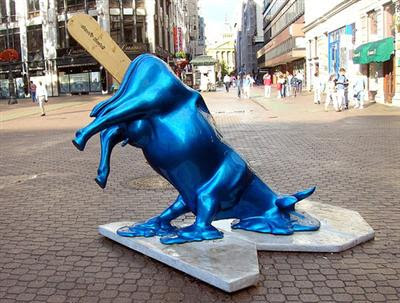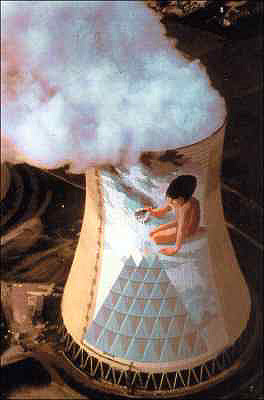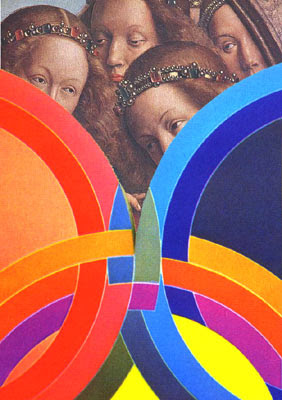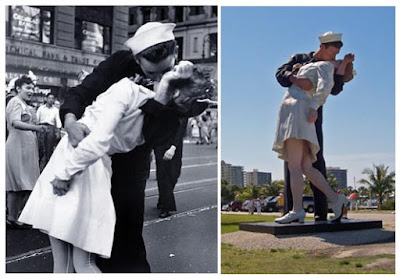Sunday, September 30, 2007
Saturday, September 29, 2007
Look alike (Creepy division)

Top: Detail of Marcus Harvey’s 1995 portrait of Myra Hindley composed of stencilled children's handprints. The painting was exhibited in Charles Saatchi’s 1997 exhibition Sensation and later purchased by Frank Gallipoli, a commodities trader based in New Canaan, Connecticut. Bottom: Hand soap, available at$US20 for 10 from the Vitamin Design Shop.
Posted by
jim and Mary
at
8:53 AM
![]()
![]()
Labels: Look alike
Friday, September 28, 2007
English as a second language
Is competition a good thing? This piece on Lot No 93 in the latest Webb’s online catalogue makes you think… um….no.
Merilyn Tweedie Compliments of Ashley wallpaper xeroxes, epoxy resin and fibreglass cloth original artist's label affixed verso 666mm x 870mm In 2005, she would not discuss her work with the New Zealand public upon her appointment as the representative of this country to the Venice Biennale. Outraged lynch mobs after her and their $500,000 of tax payer money did not change her mind/s. It is, after all, a million dollar secret, not a half-a-million dollar secret. What the public may not have realised was that to do such a thing would be to ruin the Et Al/ L Budd/ Blanche Readymade/ Merilyn Tweedie experience altogether. In fact, above all, she is a performance artist. The works she makes are relics of performance, they reek of performance. To look too hard into the face of this painting will only return you gobsmacked and feeling even a little disheveled that you didn't figure it out. The truth is, it is a compilation of jargon, layers of nonsense whose heritage is most in line with the dada movement of the early 20th Century. She and her band of monikers occupy the red herring kingdom where everything is redundant and garbling - like her installations of technological detritus - although they are beautiful works in their anti-narrativeness. Although they in themselves contain no definitive meaning, they are open to all sorts of interpretations – and people have plenty. So herein lies the irony not only is Dr P Mule a performer, but she creates the stage set and she's making a performer out of you – the viewer – in your interaction with her language of meaninglessness. Merilyn Tweedie is represented by Starkwhite, Auckland; Hamish McKay, Wellington and Jonathan Smart, Christchurch. IK
For more where that came from, go here.
Posted by
jim and Mary
at
12:39 PM
![]()
![]()
Floored
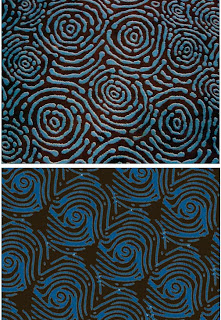
So far, five of our readers have suggested that the Auckland Airport carpet looks like the Te Papa logo. How the hell did we miss that?
Open to suggestion

In the theatre, companies gather the morning after opening night to get notes on what can be done to make the show better. If a play doesn’t capture an audience there is a crisis. The cast and crew are pulled together and they work on it plus the promotion and marketing are reviewed. If a production fails at the box office it is often pulled altogether and something else put on in its place. With feature films the audiences determine the length of the run. If people speak with their feet the movie is kicked out of the theatre. So here’s the question. Why is it that art exhibitions stay open for their full scheduled three or four months run whatever the response to them or the number of visitors? Are exhibitions ever tuned once a few hundred people have had a chance to look at it? Do curators ever bring in a few people to give notes and make suggestions of how an exhibition might be improved? What is it about art museums that has convinced them feel that their shows are perfect from day one? While we suspect this resistance will be far more about the needs of the bureaucrats (timetabling, processes, resources) than cultural confidence, it has put them in an uncomfortable corner, and nailed them there. A successful quarter-year run is a long stretch for any creative enterprise. It would be a blockbuster for a movie and Harry Potter for a novel. How many exhibitions in New Zealand warrant this amount of time unchanged or updated? (And we don’t think resting watercolours counts). Most of our museums are eager to trot out audience figures to prove their worth. What would happen if they also used their audiences to test and improve the quality of their exhibitions after opening day?
Image: People lined up for a typical exhibition at a public Art Gallery (simulation).
Posted by
jim and Mary
at
7:01 AM
![]()
![]()
Thursday, September 27, 2007
Elementary
 A Waikato reader tells us that a couple of hours ago Ruth Watson arrived unannounced at the Waikato Museum to remove her work from the Trust Waikato Contemporary Art Award exhibition. It appears that the glass-bead based floor work had been used as a play area by visiting children. We are told the director did not meet with Ruth Watson nor was any attempt was made by staff to discuss how the work could remain in the show until it ended in November. Similar works by Ruth Watson can be seen at Two Rooms in Auckland. This is the second artist protest action we have heard of this year. In Wellington, et al. commissioned a representative to deinstall her work and stack it against the wall in the City Gallery’s Prospect show.
A Waikato reader tells us that a couple of hours ago Ruth Watson arrived unannounced at the Waikato Museum to remove her work from the Trust Waikato Contemporary Art Award exhibition. It appears that the glass-bead based floor work had been used as a play area by visiting children. We are told the director did not meet with Ruth Watson nor was any attempt was made by staff to discuss how the work could remain in the show until it ended in November. Similar works by Ruth Watson can be seen at Two Rooms in Auckland. This is the second artist protest action we have heard of this year. In Wellington, et al. commissioned a representative to deinstall her work and stack it against the wall in the City Gallery’s Prospect show.
Posted by
jim and Mary
at
5:21 PM
![]()
![]()
Metro section

Twins from Hawkes Bay, and a visitor from Australia.
Images from top: Martin Popplewell, Dick Frizzell and Robert Macpherson
Posted by
jim and Mary
at
3:45 PM
![]()
![]()
Labels: Look alike
Metaphor corner

What are the designs on the carpets in the Auckland and Wellington airports trying to tell us? We assume the rocks were inspired by Wellington airport’s chairman Lloyd Morrison’s long-time interest in Michael Smither ,but the Auckland rain splatters? Or are they volcanic cones? Mud pools? Table tennis ball for the most creative suggestion.
Wednesday, September 26, 2007
Spam
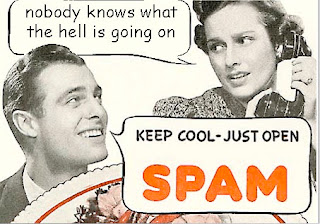
unvarnished facts, reckless guesswork, insinuations and possible inventions that have arrived at overthenet.blog@gmail.com. resource consent revisions required of the proposed addition to the auckland art gallery include lowering the roof line by 2.5 meters. this change threatens the inclusion of the top floor which was dedicated to contemporary art galleries. rohan wealleans was seen front row at tanya carlson’s show at the recent auckland fashion week. assuming there is still room a stephen bambury work is proposed as a permanent fixture in the new foyer of the revised auckland art gallery. undine marshfield continued the spirit of the trip-of-a-lifetime-tour attending the shanghai biennale. webb’s are out buying a contemporary art collection for someone or other. len lye has been selected for the next biennale of sydney. the artistic director, carolyn christov-bakargiev, describes her proposed exhibition as a “space of rotation, confusion, revolt, insubordination, anarchy and disruption of order, a space of ‘revolution’.”any missed details, indignant denials or additions gratefully received, and the one with the best rhyming couplets- rewarded.
Tuesday, September 25, 2007
Hold the bus

The latest Art+Object catalogue is a return to form for the auction house that intends bringing contemporary art auctions into the 21st century. The catalogue goes up on the Art+Auction site today and in addition to the droll Ronnie van Hout cover image I want my mummy, includes an iconic New Zealand-as-skateboard work by Francis Upritchard, an early Michael Stevenson oil painting, a monster (3340 x3870mm) Peter Robinson and a couple of Mirek Smisek’s scraffito vases.
Day for night
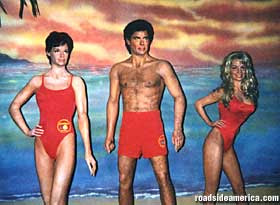
So much for our clever Night Watch segue. One of our readers, Boris, has put us right, explaining that the film by Timur Bekmambetov is actually called Dnevnoy Dozor or, in English, Day Watch. Kindly, Boris also mentioned that Rembrandt’s Night Watch is not actually a night scene, as you will have discovered if you followed the know-it-all link. Thanks for letting us off the hook Boris. At least we managed to avoid calling it Bay Watch, which is something.
Image: Rembrandt’s Bay Watch represented at the Hollywood Wax Museum. From one of our favourite sites, Roadsideamerica.com.
Posted by
jim and Mary
at
10:59 AM
![]()
![]()
Labels: grovelling apologies
Who’ll watch the watchers

Nochnoy Dozor’s great movie Nightwatch II is screening here in Wellington and reminded us of a number of versions we saw in the Netherlands of the last great commissioned painting by Rembrandt. Here, in the spirit of copycatism, they are. And for all of you who are frustrated by not knowing who the dressed-up folk in the painting are, you can take it out on this uninformative who’s-who link. “Girl in yellow dress with chicken.” ... Oh ... right ... that's who she is.
Images: Top left to right, the original housed in the Rieksmuseum, a 3D version in the Rembrandt Square. Bottom left to right, a fast food outlet near the museum, a tile mural in Delft.
Monday, September 24, 2007
Skin flicks
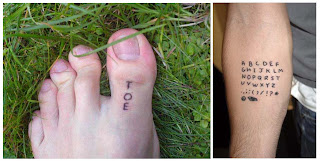
Two photographs of David Shrigley drawings people have tattooed onto themselves. More here.
Posted by
jim and Mary
at
1:38 PM
![]()
![]()
Value ad
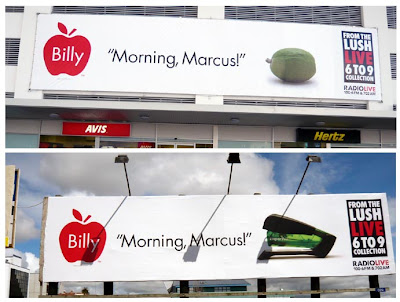
Billy Apple has returned to his advertising roots to produce the creative for Radio Live’s month long campaign. According to Admedia, Apple did five executions for Radioworks media agency OMD all featuring items associated with radio host Marcus Lush. They are a stapler, a tube of condensed milk, a Feijoa, a fold-out ruler and a Railways cup. Hopefully that means something to Lush fans. If you want Billy’s brand and a stapler as wallpaper on your Nokia, you can download it here. Apple is also working closely with Saatchi & Saatchi on the introduction and promotion of a new apple onto the New Zealand market called … er… the Billy. Does this sort of advertising work? According to our in-depth research (Google plus a bit of asking around), Apple has been mentioned in Metro magazine’s Gossip Watch three times in the last two months.
Images: Lush/Apple ads. Top, Auckland Airport. Bottom, Queen Street.
Sunday, September 23, 2007
Drawing lesson

Fifty years old this year, Jack Kerouac’s original drawing for the cover of On the road. Thanks BB.
Posted by
jim and Mary
at
8:51 AM
![]()
![]()
Thursday, September 20, 2007
Catalogue heaven
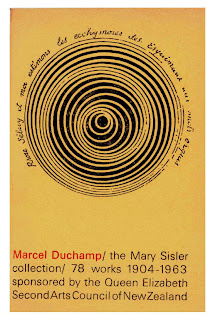
Bestof3 has pointed us to the Auckland Gallery’s terrific archive of their exhibition catalogues. It currently runs from 1954 to 1969. Among the publications you can download as pdfs is Marcel Duchamp: the Mary Sisler collection. The exhibition toured through New Zealand 40 years ago. Has a more important exhibition visited New Zealand? Recent American Art would be up there but it’s certainly hard to imagine the equivalent of either of these shows being mounted by a public art museum today. What would be a reasonable comparison? Say, a major survey of Bruce Nauman. Even in 1967 it must have been a huge effort to get such an incredible show here and even more (or less) so when you note that William S. Rubin, long-time curator of the Museum of Modern Art in New York, described Mary Sisler as “one of the strangest and most difficult women I have ever met.”
The Duchamp exhibition included Fountain which caused a great fuss in Christchurch when the director of the Robert McDougall Art Gallery, W S Baverstock, removed it from the show, and only permitted it to be seen by appointment in his office. At the opening Boyd Webb, who was a student at the time, snuck a ceramic po into the exhibition under one of the vitrines. Baverstock was incensed pushed it the length of the gallery and out the door with his foot. The day after the opening a long line of art students applied to see Fountain and, by rejoining the line, managed to keep up demand for around an hour before the Director’s secretary caught on.
Image: The Duchamp exhibition catalogue was designed by Hamish Keith
Posted by
jim and Mary
at
7:49 AM
![]()
![]()
Wednesday, September 19, 2007
All at sea

Our Lifestyle section reporters are currently working on an article about art world people and their launches, yachts and any other craft. Any help appreciated. In the meantime some essential information for all those who love the sea. Kim Kavin, editor of www.CharterWave.com has this useful information about looking after the art work on board your craft. Kim’s article begins with a story about rock superstar Lenny Kravitz who recently redecorated his Magnum 60. Here’s Kim. “Clean white fabrics now rest where cow prints once blared, a white mink comforter slathers the bed, and just a hint of gray peeks through the white shag carpeting that oozes about five inches off the sole.
“Only one piece of artwork adorns the bulkheads inside the stark, minimalist interior: a gold-framed Joan Miro that stands about 10-by-12 inches, around the same size as some of the artist's $30,000 unframed canvases. Kravitz's piece is tucked behind glass in his yacht's saloon, which is just a few steps down from a wide open door to the sun, sand and salt air.”
As Kim says, “No matter what style of display boaters choose, art is meant to be enjoyed. Sun and seawater are formidable opponents, but they're not insurmountable obstacles.” You can read the full, informative article here.
Tuesday, September 18, 2007
Just the FAQs

The current departmental collection FAQs on the Te Papa web site.
NATURAL ENVIRONMENT
What can you tell me about the pygmy blue whale?
How was the pygmy blue whale in Mountains to Sea prepared for display?
What is a moa?
What can you tell me about tuatara?
How do tuatara live?
Are tuatara endangered?
What is kauri gum?
What can you tell me about the pohutakawa tree?
Who are the contacts for enquiries about botany?
What type of dinosaur does Te Papa's dinosaur bone belong to?
Where was Te Papa's dinosaur bone found?
Who is Joan Wiffen?
What can you tell me about the kea?
What are the different kinds of kiwi?
What can you tell me about volcanoes?
What do I do if I find a bird with a band around its leg?
What can you tell me about the weta?
What are the main facts of the Wahine disaster?
Where is New Zealand pounamu (nephrite jade) found?
What can you tell me about the colossal squid?
How many native tress and shrubs are planted in Bush City?
What can you tell me about Nga Kakahu a Papataanuku (Te Papa's iwi planting area)
HISTORY
What can you tell me about the de Surville anchor?
Who discovered the de Surville anchors?
What happened to Phar Lap's remains?
What is the Tamil Bell?
What can you tell me about Te Papa's Pacific Collection?
What can you tell me about the Britten motorbike
What can you tell me about the Tiger Moth?
What can you tell me about the Endeavour cannon?
What is the Treaty of Waitangi? What do the articles of the Treaty of Waitangi contain?
What can you tell me about the Zhang Heng earthquake recorder?
How does the Zhang Heng seismograph work?
Who was Hone Heke?
Where is the sarcophagus and the Egyptian mummy?
What can you tell me about the Egyptian mummy?
Who was Sir James Hector?
Where is Captain Cook's cloak?
What can you tell me about Captain Cook's cloak?
MAORI/ TAONGA MAORI
What can you tell me about Te Papa's waharoa in the Wellington foyer?
What is Te Marae o Te Papa Tongarewa?
What is the protocol on The Marae?
What is the powhiri (welcome)?
When does the kawa (protocol) change?
What can you tell me about the Mauri Stone in The Marae?
What can you tell me about Te Hau ki Taranga?
What is Teremoe?
What is Te Aurere?
Where do Maori and Pacific Island people come from?
What is Matariki?
Where are toi moko, also called moko mokai (tattooed, dried human heads)?
ART & VISUAL CULTURE
What can you tell me about Charles Goldie?
What happened to the Academy of Fine Arts?
Image: Question mark
Monday, September 17, 2007
Lookalike XX

Images: Left, Pixelgarten (artists Adrian Nießler and Catrin Altenbrandt.
from Frankfurt, Germany). Right, Rene Magritte, The Lovers
Posted by
jim and Mary
at
2:42 PM
![]()
![]()
Labels: Look alike
Art student corner

To examine the power dynamics of a student photography class session, American artist Andrew Schroeder retained two attorneys to represent his intellectual interests in a round-table discussion. The attorneys spoke on his behalf during the class always referring to him in the third-person as "my client".
This reminded us of Boyd Webb’s final submission for Honours at the Ilam School of Fine Arts. Webb hired a secretary to represent him when examiners came to assess his final work. The secretary fielded all the examiners’ questions. In response to any questions about the work she would reach into a filing cabinet to retrieve examples (photographic depictions of his sculptures and performances). Occasionally Webb would phone the secretary from another location to check on progress.
Image: frame from Andrew Schroeder's DVD of the event
Posted by
jim and Mary
at
7:05 AM
![]()
![]()
Sunday, September 16, 2007
Sunday comics

It's not often (unless you're et al.) that contemporary art installations appear in cartoon form. Here's Neil Dawson's Ferns as part of an illustration by Paul Clarkson in yesterday's Dominion Evening Post. The article - "Who will be mayor?"
Saturday, September 15, 2007
Friday, September 14, 2007
Catch up I

A blatant promotion of older posts through showing you strange new images. This time (left) the Gelitin bunny gets a snow job, and a double take on camouflage (right).
Posted by
jim and Mary
at
12:37 PM
![]()
![]()
Art is where you find it
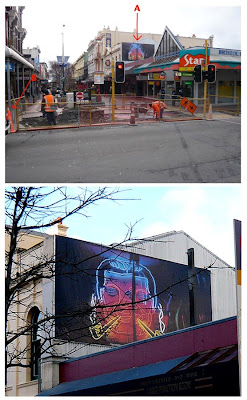
Or in this case where you can hardly see it. This billboard (A) appeared in Wellington, um… sometime in the last month or so. Thanks to climbing on a pillar support (B) we can tell you that this Paul Hartigan work is called something like Two Bob a.k.a Puff Daddy… the rest is invisible to all but the seagulls. Who put it there? What is it all about? Table tennis ball anyone?
Posted by
jim and Mary
at
6:40 AM
![]()
![]()
Thursday, September 13, 2007
If you go rafting, don't forget to take a book

For anyone who got The Raft of the Medusa bug from our recent posting, you might like to check out Albert Alhadeff's book available at Amazon.com.
Posted by
jim and Mary
at
9:19 AM
![]()
![]()
Sting-a-ling-a-ling

All the skulls in the September 2007 issue of Art Forum
Images: Left column from the top, Candice Breitz, Sherry Levine, Tony Tasset, Kent Henricksen, Lee Hyunhkoo. Right column from the top, Chiho Aoshima, Chris Marker, Steven Gregory and Anon from the Cheim & Read ad for I am as you will be: the skeleton in art.
Posted by
jim and Mary
at
7:37 AM
![]()
![]()
Wednesday, September 12, 2007
Prop

Apart from ‘nearly becoming an All Black,’ one of the most famous things New Zealand artist Ted Bullmore did was to have his work purchased by film maker Stanley Kubrick in the late 1960s. The work was a painted construction from his Astroform series, which was to evolve into his highly sexualised Icon series. It was no doubt this sexual reference that encouraged Kubrick to include the Bullmore in the set for Mr Alexander’s (Patrick Magee) home in his film A Clockwork Orange. The heart-shaped Bullmore can be seen in the colour image on the back right wall with the Lodger (Clive Francis) in the foreground. In the black and white images the Bullmore work is slightly obscured above the central figure’s head. Kubrick is seated in the foreground. Ted Bullmore spent ten years as an artist and part-time teacher in London before returning to New Zealand in 1969. He then taught at Rotorua Boys High School until his death in 1978.
Images: Left, still from A Clockwork Orange directed by Stanley Kubrick and released in 1971. Right, photos taken during the filming of A Clockwork Orange. Click on image to enlarge.
Posted by
jim and Mary
at
7:03 AM
![]()
![]()
Labels: art in the movies
Tuesday, September 11, 2007
Lifestyle section
In our August 2 Lifestyle report we sprang details from our exhaustive overthenetsurvey. As the Eames chair featured as an important item for many art lifestyles, we thought you would enjoy this film featuring the introduction of the Eames chair on NBC in 1956 by its namesake, Charles Eames.
DIY
Here’s an opportunity to have a terrific collection of contemporary art by some of the world’s greatest artists all for the cost of materials. Thanks to the New Zealand art/life blog one moment caller, we were pointed to DO IT at e-flux. DO IT is an exhibition conceived by Hans Ulrich Obrist that began in 1993. Obrists’s concept was an “exhibition of do-it-yourself descriptions or procedural instructions which, until a venue is found, exists in a static condition. Like a musical score, everything is there but the sound.” The site gives access to a large number of art concepts waiting to be completed by whoever wants to create them. Artists who have contributed include Marina Abramovic, John Baldessari, Matthew Barney, Christian Boltanski, Louise Bourgeois, Liam Gillick, Dan Graham, Gilbert & George, Felix Gonzalez-Torres, Douglas Gordon, Mona Hatoum, Mike Kelley, Paul McCarthy, Annette Messager, Bruce Nauman, Yoko Ono, Nam June Paik, Steven Pippin, Michelangelo Pistoletto, Jason Rhoades, Pipilotti Rist, Martha Rosler, Andreas Slominski, Rirkrit Tiravanija, Rosemarie Trockel and Lawrence Weiner. Mike Kelley’s work asks you to make a recording and send it to him in LA. Gonzalez-Torres gives instructions for his famous candy-in-a-corner-of-the-room work using locally sourced candy. Examples of work that has already been made are also available on the DO IT site. Above our new Paul McCarthy Untitled 1969. The instructions: Place dirt in a box or bucket. Paint entire object silver.
Image: Paul McCarthy Untitled 1969
Posted by
jim and Mary
at
7:40 AM
![]()
![]()
Monday, September 10, 2007
Warning to collectors
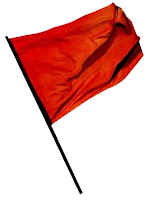 “Barber’s paintings plot the coordinates to the WASP lifestyle of his own clientele, almost like preordained portraits. Which is just a nice way of saying they’re really high-end pranks… in the end Barber gives the rich what they really want to see, ie. pictures of themselves.”
“Barber’s paintings plot the coordinates to the WASP lifestyle of his own clientele, almost like preordained portraits. Which is just a nice way of saying they’re really high-end pranks… in the end Barber gives the rich what they really want to see, ie. pictures of themselves.”
Press Release for Andrew Barber’s exhibition at Starkwhite
Posted by
jim and Mary
at
3:59 PM
![]()
![]()
Labels: collectors
Newsflash. Diana not dead!

The Diana camera was made by Hong Kong’s Great Wall Plastic Factory in the 60s and went out of production over 25 years ago. This is the camera that Peter Peryer used briefly in 1975 to take evocative images like the one above from his Mars Hotel portfolio. Now the people at Lomography intend to bring the Diana back into production. The moody, dark-haloed pictures that the Diana creates are right in the zone for Lomography fans and will give similar results to their popular Holga camera. Apparently they are putting a few new features on the new Diana including a 4 F stop (whatever that means) and a removable lens, so you can take pin-hole camera shots. Apart from these enhancements, the camera will look pretty much like the original, pictured above.
Images: Left, Peter Peryer’s Divided House from Mars Hotel. Right, the original Diana camera
Posted by
jim and Mary
at
7:04 AM
![]()
![]()
Sunday, September 09, 2007
Copy cats

This picture shows a facsimile painting competition in full swing in Dafen, a village in South China. Over 100 contestants painting to the clock. As we have already posted, China is the place to go to for mass-produced works of art. Some villages claim to create five million copies of masterpieces every year. A good “artist” can create around 30 paintings a day. Around 60 percent of all the cheap oil paintings in the world are made there the business being worth somewhere in the vicinity of $56 million a year.
According to Spiegel online “A reasonably skilful copy of Van Gogh's "Sunflowers" sells for €40 ($51). Buy 100 and the price goes down to €26 ($33), the gallery workers points out. The 100 paintings, guaranteed to have been produced by art academy graduates, ship within three weeks.”
Saturday, September 08, 2007
Art is where you find it 10
 This site allows prospective buyers of apartments at 650 Sixth Ave at 20th in New York to check out how art will look on the whiter than white walls. The developers have joined with an art gallery to let prospective buyers “curate” their own rooms, and presumably purchase the art to have it ready when they move, thus aligning this virtual world with reality. Possibly worth 10 to 15 seconds of your time, but be warned, the art comes under rubrics like “Branded consciousness”, Found objects and forgotten stories” and “Abstract expressions.” To get “curating”, click on the Chinese food containers when you reach the home page.
This site allows prospective buyers of apartments at 650 Sixth Ave at 20th in New York to check out how art will look on the whiter than white walls. The developers have joined with an art gallery to let prospective buyers “curate” their own rooms, and presumably purchase the art to have it ready when they move, thus aligning this virtual world with reality. Possibly worth 10 to 15 seconds of your time, but be warned, the art comes under rubrics like “Branded consciousness”, Found objects and forgotten stories” and “Abstract expressions.” To get “curating”, click on the Chinese food containers when you reach the home page.
Posted by
jim and Mary
at
7:21 AM
![]()
![]()
Labels: Art is where you find it
Friday, September 07, 2007
Guide to collectors 14
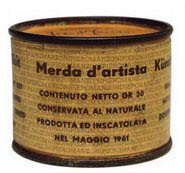
The sixth thing you should know about Manzoni’s shit.
His father owned a canning factory.
Posted by
jim and Mary
at
3:52 PM
![]()
![]()
Your tax dollars at work
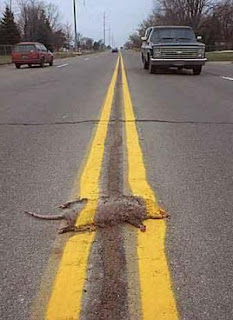
This link takes you to at a page where you can download Creative New Zealand’s annual recurrent funding for 2008. You will remember that when we looked at the composition of the Board of CNZ we found that of the seven members, three had a specific interest in music, two in theatre, three in dance and…oh that’s right...none in the fine arts. So how did music, dance and theatre go? This is broad-brush, but you’ll get the picture.
Of the total $15 million distributed:
- 31.5 per cent went to theatre
- 39 percent went to music
- 8 percent to dance
- 1.3 percent to craft
The fine arts received the following:
- Artists Alliance $130,000
- Artspace $320,000
- Moving Image Centre $300,000
- The Physics Room Trust $166,720
Image: The first picture that comes up when you Google “Your tax dollars at work.” (Image reversed to suit New Zealand road conditions). And yes, we don’t include Arts Access Aotearoa in the fine arts figure, but if we had it would have been bumped up 2 percent. The Artist Alliance is included to be nice.
Thursday, September 06, 2007
Five times invitation

Over at stimulusresponse is a response to five gallery invitations received in the mail a couple of days ago. The response takes the form of ten photos.
Posted by
Pippin
at
10:52 AM
![]()
![]()
Labels: stimulusresponse
The catalogue (and the gallery) with the hole in the middle

This catalogue from the Dunedin Public Art Gallery can be added to the growing pile of work produced by Justin Paton. This time he is alongside the Hocken’s Linda Tyler. With an elegantly cut-out cover in signature purple, a hole that burrows through the first twelve pages, and another 60 full colour pages behind that, this is an impressive publication and another nifty design job by Karina McLeod. If Rohan contributed nothing else to New Zealand culture (he has and will), "Horrorgami" will do just fine. Justin is about to leave the Dunedin Public Art Gallery and head a little north to Christchurch. Since arriving in Dunedin he has whipped up a storm of catalogues, shows and essays including major efforts on Jeffrey Harris, Laurence Aberhart, Julia Morison, Don Peebles, Ronnie van Hout, Ricky Swallow, Daniel von Sturmer, Anne Noble – you get the picture. Priscilla Pitts and Justin Paton both leaving the gallery at the same time is a big challenge. We assume Tim Walker will be filling both positions.
Posted by
jim and Mary
at
7:01 AM
![]()
![]()
Wednesday, September 05, 2007
Warning to collectors
“What I love to do is put people in front of art and make them feel it, make them stop everything else they are doing and experience it, deeply. That's how I make art expensive. And that's my job.”
Tobias Meyer, chief auctioneer and worldwide head of contemporary art at Sotheby's, in The New Yorker
Posted by
jim and Mary
at
2:03 PM
![]()
![]()
Up the down staircase

We’ve dabbled in fringe Escher art before. This time it’s a video game creating 3d world’s from Escher drawings. Planned for release on PlayStation later this year Echochrome will let you direct small marionette-like figures through Escher’s impossible structures. And this is not the only video game that features art. You can also look for Oblivion a game where you try to save a painter known as Rythe who has fallen into one of his own paintings. To find out more about Echochrome go here.
Posted by
jim and Mary
at
7:04 AM
![]()
![]()
Tuesday, September 04, 2007
Courtyard

News just in that the Environmental Court has upheld the Resource Consent for Auckland Art Gallery’s extensions. The court which had seen the plans, and we presume the model pictured above, thought that apart from needing a bit of work on the roof, it sounded fine.
Posted by
jim and Mary
at
12:33 PM
![]()
![]()
Labels: auckland art gallery
For the record

Overthenet is nearly one year old, so we are gathering together disks for our annual DJ party. Any other suggestions welcome.
Posted by
jim and Mary
at
10:04 AM
![]()
![]()
Lights. Camera. Auction!

On Sunday night we caught the second part of the doco on the launch of Art+Object. It certainly looked different to the auctions we've been to in the past. For a start there was smartly displayed work, that didn’t look like it had come out of a regional museum’s study collection. TVNZ got into the spirit with a Reservoir Dogs-like graphic and the Art + Object team had a great whew-thank-god-it-worked moment on camera at the end. Ben Plumbly captured the mood when he declared, “We’ve broken the mould.” So, clever timing to find the latest Art+Object catalogue for the Gow Collection in the mail yesterday. Nothing wrong with the collection of objects either, in fact it’s a pretty interesting read. Bev and Murray Gow have put together a wide range of stuff and it’s good to have a chance to ruffle through it. And yet, with its A4 format, a number of works that would have been better discretely sold off line, and illustrations that seem more arranged than designed, this auctiosure seems a long way off brand from Art+Object as the “The 21st Century Auction House”.
Images: Middle, the Gow Collection catalogue from Art+Object. Outer, scenes from the TVNZ documentary on Art+Object's first auction.
Posted by
jim and Mary
at
6:53 AM
![]()
![]()
Monday, September 03, 2007
Let's put up a statue of...um.. I know ... Me!

What is it about despots and sculpture? Memories of four years ago and the toppling of Saddam Hussein's statue by US marines in central Baghdad square sent us scurrying for other examples of this fringe activity. Now that there is talk of removing the giant cross-swords monument erected 18 years ago at the end of the Iran-Iraq war, the search, and recognition of these great works, feels even more urgent. Here then, with some help from the Guardian, is the best of the best, as it were. We’ve already mentioned The Hands of Victory in Baghdad as a leader in its field, but a close second for the metaphor prize is Fist Crushing U.S. Fighter Plane out of Col. Muammar al-Gaddafi’s Libya. A special mention in this class goes to the Monument to the Founding of the North Korean Workers' Party. Best sculpture of a despotic leader pointing his finger in the air, is tied between the Monument to President Laurent Kabila Kinshasa of the Democratic Republic of Congo and President Kim Il Sung of Korea. And the specialty gold-leaf award was carried away by the Monument to President Saparmurat Niyazov in Ashgabat, Turkmenistan.
Images: Clockwise from top left, Fist Crushing U.S. Fighter Plane, Monument to President Saparmurat Niyazov, Monument to President Laurent Kabila Kinshasa, President Kim Il Sung of Korea, Monument to the Founding of the North Korean Workers' Party and The Hands of Victory.
Posted by
jim and Mary
at
7:05 AM
![]()
![]()
Sunday, September 02, 2007
Stephen Birch
 Stephen Birch died yesterday and, although he has been ill for some time now, it is still a shock. Stephen exhibited with Hamish McKay and Michael Lett here in New Zealand and we have a couple of great works of his. The last time we talked with Stephen he was walking into his survey show, Looking out my back door at the MCA in Sydney. We weren’t able to get over and had rung to wish him well. As was usual whenever we spoke, he was much more interested in how we were and how we felt about lending to the show, than his own big moment of recognition. His work was curious, courageous and presented with a wonderful mix of whimsy and challenge. You can tell from the catalogue of the MCA show that Stephen was on a roll. It is incredibly sad that his time has been cut so short.
Stephen Birch died yesterday and, although he has been ill for some time now, it is still a shock. Stephen exhibited with Hamish McKay and Michael Lett here in New Zealand and we have a couple of great works of his. The last time we talked with Stephen he was walking into his survey show, Looking out my back door at the MCA in Sydney. We weren’t able to get over and had rung to wish him well. As was usual whenever we spoke, he was much more interested in how we were and how we felt about lending to the show, than his own big moment of recognition. His work was curious, courageous and presented with a wonderful mix of whimsy and challenge. You can tell from the catalogue of the MCA show that Stephen was on a roll. It is incredibly sad that his time has been cut so short.
Image: Detail from Stephen Birch's Civic Minded 1999
Posted by
jim and Mary
at
3:47 PM
![]()
![]()
August

This month we: were amazed that the City Gallery had been at its current location with its current director for 14 years • followed it up with a chart of time served by art gallery directors • made many, many unsuccessful attempts to get the Trip Of A Lifetime Tour reports from CNZ • spent too much time searching for images of Géricault’s The Raft of the Medusa • realised you could start a good art collection cheap with available New Zealand multiples and editions • came up with a terrific idea for art dissertations • reported on art lifestyle choices and generally tried to brighten your day with facts, guesswork, insinuation and invention.
Image: August Sander
Posted by
jim and Mary
at
9:37 AM
![]()
![]()
